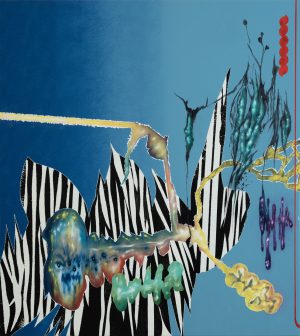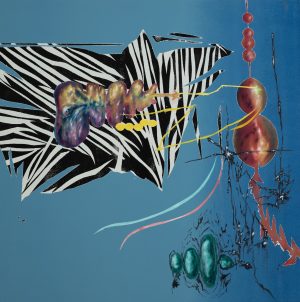
Róka Csaba KIS
Aliens Should Not Try To Act Like People
- Year(s)
- 2022
- Technique
- oil, enamel, canvas
- Size
- 100×89,5 cm
Artist's introduction
As a leading painter of Hungarian posthuman hybridity, he has been a regular participant in solo and group exhibitions for two decades, both on the local and the international scene. These include the Liverpool Biennial in 2010, a group exhibition at the Factory-Art Gallery in Berlin in 2011, then due to its impact, being added to the collection of the private MACT/CACT Museum and Center of Contemporary Art in Switzerland, and after 2011, one more Esterházy Art Award nomination in 2023. For the fourth time in his career, the central problem of his painting, the representation of the human figure, is ricocheted. While the few years following his graduation in 2007 were essentially characterised by the dynamic, dramatic contrasts of classical painting traditions such as Baroque and Romanticism, with a satirical overtone, in a naturalistic, horroristic narrative composition of colour and form, from the mid-2010s – having completely stripped of the realist approach – the influence of surrealism unfolded in the contrasting laboratory of “quite absurd, almost caricaturistically pathological subject matter”, as Gábor Rieder wrote on the artist’s exhibition titled Federation Of Decomposed Organs And Stripes. However, the distorted fragmentation of the human figure in his paintings reached its peak after 2020, as the human body parts became completely separated from their self-referentiality. The works from the same series, shown in the collection, are now abstract, deconstructed painting elements floating in the space of the picture, like the filtered presence of a cartoon character on another reality. The associative black and white stripe stamp, which is at once zebra carpet, hard-edge veneer constructions and the discount barcode of capitalist society, is applied to a predominantly colour-transitioned base layer, reminiscent of the typical colour palette of American car tuning. As a final layer of paintings, Kis Róka painted the deformed creatures, often distorted pop-cultural references, with the "melted gummy bear" effect of water-based enamel paint (Bad And Naughty, 2021). In the spring of 2023, however, the artist completely erased his hardware and dissolved the image space of his works in the pixel art bitmap matrix of trash aesthetics, making the distorted fragmentary creatures take full shape as stick figures again. Annamária Szabó
More artworks in the artist's collection »










